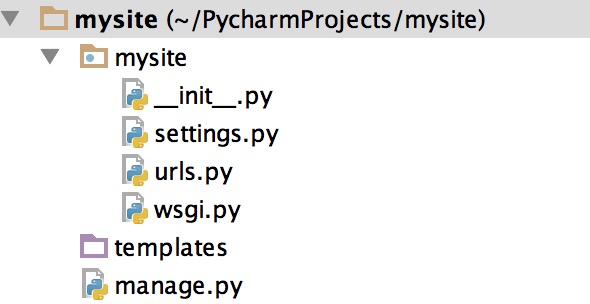Python的WEB框架有Django、Tornado、Flask 等多种,Django相较与其他WEB框架其优势为:大而全,框架本身集成了ORM、模型绑定、模板引擎、缓存、Session等诸多功能。
1,基本配置
一、创建django程序
终端命令:django-admin startproject sitename
IDE 创建Django程序时,本质上都是自动执行上述命令
其他常用命令:
python manage.py runserver 0.0.0.0
python manage.py startapp appname
python manage.py syncdb
python manage.py makemigrations
python manage.py migrate
python manage.py createsuperuser
二,程序目录

三、配置文件
1、数据库
DATABASES = { 'default': { 'ENGINE': 'django.db.backends.mysql', 'NAME':'dbname', 'USER': 'root', 'PASSWORD': 'xxx', 'HOST': '', 'PORT': '', } }
# 由于Django内部连接MySQL时使用的是MySQLdb模块,而python3中还无此模块,所以需要使用pymysql来代替 # 如下设置放置的与project同名的配置的 __init__.py文件中 import pymysql pymysql.install_as_MySQLdb()
2、模版
TEMPLATE_DIRS = ( os.path.join(BASE_DIR,'templates'), )
3、静态文件
STATICFILES_DIRS = ( os.path.join(BASE_DIR,'static'), )
model
到目前为止,当我们的程序涉及到数据库相关操作时,我们一般都会这么搞:
- 创建数据库,设计表结构和字段
- 使用 MySQLdb 来连接数据库,并编写数据访问层代码
- 业务逻辑层去调用数据访问层执行数数据库操作

import MySQLdb def GetList(sql): db = MySQLdb.connect(user='root', db='wupeiqidb', passwd='1234', host='localhost') cursor = db.cursor() cursor.execute(sql) data = cursor.fetchall() db.close() return data def GetSingle(sql): db = MySQLdb.connect(user='root', db='wupeiqidb', passwd='1234', host='localhost') cursor = db.cursor() cursor.execute(sql) data = cursor.fetchone() db.close() return data
django为使用一种新的方式,即:关系对象映射(Object Relational Mapping,简称ORM)。
PHP:activerecord
Java:Hibernate
C#:Entity Framework
django中遵循 Code Frist 的原则,即:根据代码中定义的类来自动生成数据库表。
一、创建表
1、基本结构
from django.db import models class userinfo(models.Model): name = models.CharField(max_length=30) email = models.EmailField() memo = models.TextField()

1、models.AutoField 自增列 = int(11) 如果没有的话,默认会生成一个名称为 id 的列,如果要显示的自定义一个自增列,必须将给列设置为主键 primary_key=True。 2、models.CharField 字符串字段 必须 max_length 参数 3、models.BooleanField 布尔类型=tinyint(1) 不能为空,Blank=True 4、models.ComaSeparatedIntegerField 用逗号分割的数字=varchar 继承CharField,所以必须 max_lenght 参数 5、models.DateField 日期类型 date 对于参数,auto_now = True 则每次更新都会更新这个时间;auto_now_add 则只是第一次创建添加,之后的更新不再改变。 6、models.DateTimeField 日期类型 datetime 同DateField的参数 7、models.Decimal 十进制小数类型 = decimal 必须指定整数位max_digits和小数位decimal_places 8、models.EmailField 字符串类型(正则表达式邮箱) =varchar 对字符串进行正则表达式 9、models.FloatField 浮点类型 = double 10、models.IntegerField 整形 11、models.BigIntegerField 长整形 integer_field_ranges = { 'SmallIntegerField': (-32768, 32767), 'IntegerField': (-2147483648, 2147483647), 'BigIntegerField': (-9223372036854775808, 9223372036854775807), 'PositiveSmallIntegerField': (0, 32767), 'PositiveIntegerField': (0, 2147483647), } 12、models.IPAddressField 字符串类型(ip4正则表达式) 13、models.GenericIPAddressField 字符串类型(ip4和ip6是可选的) 参数protocol可以是:both、ipv4、ipv6 验证时,会根据设置报错 14、models.NullBooleanField 允许为空的布尔类型 15、models.PositiveIntegerFiel 正Integer 16、models.PositiveSmallIntegerField 正smallInteger 17、models.SlugField 减号、下划线、字母、数字 18、models.SmallIntegerField 数字 数据库中的字段有:tinyint、smallint、int、bigint 19、models.TextField 字符串=longtext 20、models.TimeField 时间 HH:MM[:ss[.uuuuuu]] 21、models.URLField 字符串,地址正则表达式 22、models.BinaryField 二进制 23、models.ImageField 图片 24、models.FilePathField 文件

1、null=True 数据库中字段是否可以为空 2、blank=True django的 Admin 中添加数据时是否可允许空值 3、primary_key = False 主键,对AutoField设置主键后,就会代替原来的自增 id 列 4、auto_now 和 auto_now_add auto_now 自动创建---无论添加或修改,都是当前操作的时间 auto_now_add 自动创建---永远是创建时的时间 5、choices GENDER_CHOICE = ( (u'M', u'Male'), (u'F', u'Female'), ) gender = models.CharField(max_length=2,choices = GENDER_CHOICE) 6、max_length 7、default 默认值 8、verbose_name Admin中字段的显示名称 9、name|db_column 数据库中的字段名称 10、unique=True 不允许重复 11、db_index = True 数据库索引 12、editable=True 在Admin里是否可编辑 13、error_messages=None 错误提示 14、auto_created=False 自动创建 15、help_text 在Admin中提示帮助信息 16、validators=[] 17、upload-to
应用场景:
一对多:当一张表中创建一行数据时,有一个单选的下拉框(可以被重复选择)
例如:创建用户信息时候,需要选择一个用户类型【普通用户】【金牌用户】【铂金用户】等。
多对多:在某表中创建一行数据是,有一个可以多选的下拉框
例如:创建用户信息,需要为用户指定多个爱好
一对一:在某表中创建一行数据时,有一个单选的下拉框(下拉框中的内容被用过一次就消失了
例如:原有含10列数据的一张表保存相关信息,经过一段时间之后,10列无法满足需求,需要为原来的表再添加5列数据
二、操作表
1、基本操作

# 增 # # models.Tb1.objects.create(c1='xx', c2='oo') 增加一条数据,可以接受字典类型数据 **kwargs # obj = models.Tb1(c1='xx', c2='oo') # obj.save() # 查 # # models.Tb1.objects.get(id=123) # 获取单条数据,不存在则报错(不建议) # models.Tb1.objects.all() # 获取全部 # models.Tb1.objects.filter(name='seven') # 获取指定条件的数据 # 删 # # models.Tb1.objects.filter(name='seven').delete() # 删除指定条件的数据 # 改 # models.Tb1.objects.filter(name='seven').update(gender='0') # 将指定条件的数据更新,均支持 **kwargs # obj = models.Tb1.objects.get(id=1) # obj.c1 = '111' # obj.save() # 修改单条数据
2、进阶操作(了不起的双下划线)
利用双下划线将字段和对应的操作连接起来

# 获取个数 # # models.Tb1.objects.filter(name='seven').count() # 大于,小于 # # models.Tb1.objects.filter(id__gt=1) # 获取id大于1的值 # models.Tb1.objects.filter(id__lt=10) # 获取id小于10的值 # models.Tb1.objects.filter(id__lt=10, id__gt=1) # 获取id大于1 且 小于10的值 # in # # models.Tb1.objects.filter(id__in=[11, 22, 33]) # 获取id等于11、22、33的数据 # models.Tb1.objects.exclude(id__in=[11, 22, 33]) # not in # contains # # models.Tb1.objects.filter(name__contains="ven") # models.Tb1.objects.filter(name__icontains="ven") # icontains大小写不敏感 # models.Tb1.objects.exclude(name__icontains="ven") # range # # models.Tb1.objects.filter(id__range=[1, 2]) # 范围bettwen and # 其他类似 # # startswith,istartswith, endswith, iendswith, # order by # # models.Tb1.objects.filter(name='seven').order_by('id') # asc # models.Tb1.objects.filter(name='seven').order_by('-id') # desc # limit 、offset # # models.Tb1.objects.all()[10:20] # group by from django.db.models import Count, Min, Max, Sum # models.Tb1.objects.filter(c1=1).values('id').annotate(c=Count('num')) # SELECT "app01_tb1"."id", COUNT("app01_tb1"."num") AS "c" FROM "app01_tb1" WHERE "app01_tb1"."c1" = 1 GROUP BY "app01_tb1"."id"
3、连表操作(了不起的双下划线)
利用双下划线和 _set 将表之间的操作连接起来
 创建表
创建表
from django.db import models # Create your models here. class UserInfo(models.Model): user = models.CharField(max_length=32) email = models.EmailField(max_length=32) pwd = models.CharField(max_length=64) user_type = models.ForeignKey('UserType') class UserType(models.Model): nid = models.AutoField(primary_key=True) caption = models.CharField(max_length=16) class Host(models.Model): hid = models.AutoField(primary_key=True) hostname = models.CharField(max_length=32) ip = models.CharField(max_length=32) class Group(models.Model): gid = models.AutoField(primary_key=True) name = models.CharField(max_length=16) h2g = models.ManyToManyField('Host')

# 三种创建数据方法 # obj = models.Usertype(caption ='管理员' ) # obj.save() # # models.Usertype.objects.create(caption='普通用户') # # obj = { # 'caption':'Guest' # } # models.Usertype.objects.create(**obj) # 建议使用这一种方法 # userinfo_dict = { # 'user':'张岩林', # 'email':'123@qq.com', # 'pwd':'123', # 'user_type_id':1, # } # userinfo_dicts = { # 'user':'aylin', # 'email':'124@qq.com', # 'pwd':'1333', # 'user_type':models.Usertype.objects.get(uid=3), # } # models.Userinfo.objects.create(**userinfo_dict) # models.Userinfo.objects.create(**userinfo_dicts)

# 单表查询,查询结果是queryset对象 # ret = models.Usertype.objects.all() # print(ret) # 结果<QuerySet [<Usertype: Usertype object>, <Usertype: Usertype object>, <Usertype: Usertype object>]> # for item in ret: # print(item.caption) # 取值管理员,普通用户,guest # 单独只取一列 vlaues # ret = models.Usertype.objects.all().values('caption') # print(ret) # for i in ret: # print(i,type(i)) # {'caption': '管理员'} <class 'dict'> # 可以通过变量取到关联表的对象后面加入.caption取另一个表的内容 # ret = models.Userinfo.objects.all() # print(ret,type(ret)) # for item in ret: # print(item.user,item.user_type.caption) # item.user_type取到的是usertype的对象,所以可以取caption # 连表查询之双下划线 # ret = models.Userinfo.objects.all().values('user','user_type__caption') # print(ret) # 过滤所有用户类型是管理员的用户(连表查询) # ret = models.Userinfo.objects.filter(user_type__caption="管理员").values('user', 'user_type__caption') # print(ret) # 反向查找_set # 过滤取出第一个是管理员的哪一行数据 # obj = models.Usertype.objects.filter(caption='管理员').first() # print(obj.uid) # print(obj.caption) # print(obj.userinfo_set.all()) # obj = models.Usertype.objects.filter(userinfo__user='张岩林').values('userinfo__user') # print(obj)

# 多对多操作 # 添加数据 # models.Host.objects.create(hostname='c1', ip='1.1.1.1') # models.Host.objects.create(hostname='c2', ip='1.1.1.2') # models.Host.objects.create(hostname='c3', ip='1.1.1.3') # models.Host.objects.create(hostname='c4', ip='1.1.1.4') # models.Host.objects.create(hostname='c5', ip='1.1.1.5') # # models.Group.objects.create(name='财务部') # models.Group.objects.create(name='人事部') # models.Group.objects.create(name='公关部') # models.Group.objects.create(name='技术部') # models.Group.objects.create(name='运营部') # models.Group.objects.create(name='销售部') # models.Group.objects.create(name='客服部') # 将多台机器,分配给一组【财务部】 # obj = models.Group.objects.get(gid=1) # obj.h2g.add(*models.Host.objects.all()) # print(obj.h2g.all()) # <QuerySet [<Host: Host object>, <Host: Host object>, <Host: Host object>, <Host: Host object>, <Host: Host object>]> # 将一台机器,分配给多个组 # 方法一 只能一个一个添加 # host = models.Host.objects.get(hid=1) # group = models.Group.objects.get(gid=4) # group.h2g.add(host) # 方法二 添加多条 # h = models.Host.objects.get(hid=4) # h.group_set.add(*models.Group.objects.filter(gid__gt=3)) # 方法三 # h =models.Host.objects.get(hid=2) # ret = h.group_set.set(models.Group.objects.filter(gid__gt=3)) # print(ret,type(ret)) # 删除语句 # h = models.Host.objects.get(hid=2) # h.group_set.remove(*models.Group.objects.filter(gid__gt=3)) # 危险删除方法,慎用,会把分组表里的分组也会给删掉 # h.group_set.all().delete() # 补充,add添加可以添加数字 # h = models.Host.objects.get(hid=1) # h.group_set.add(1) # h.group_set.add(models.Group.objects.get(gid=1)) # h.group_set.add(*[2,3]) # h.group_set.add(*models.Group.objects.filter(gid__gt=1)) # 两个表都添加数据 # h = models.Host.objects.get(hid=2) # h.group_set.get_or_create(name = "人事部") # h.group_set.update_or_create(name="技术部") return HttpResponse("OK")

# h = models.Host.objects.get(hid=1) #models.Host.objects.filter(hid__gt=5).delete() #会删除关系表的 也会删除原始表的 # h.group_set.all().delete() # 只删除关系表中的数据 # h.group_set.remove(*models.Group.objects.filter(gid__gt=2)) # 修改 set 不能做修改 如果有就保留 删除其他 # h.group_set.set(models.Group.objects.filter(gid=8)) # 修改 set 如果有就保留 没有就添加 # h.group_set.set(models.Group.objects.filter(gid__gt=2)) # clear 默认是false 来行数据添加 clear=True 先清除后添加新数据 #h.group_set.set(models.Group.objects.filter(gid=2),clear=True) # models.Group.objects.filter(gid__gt=5).delete() # h = models.Host.objects.get(hid=1) #关系表里面存在不管,如果不存在两个都加 # h.group_set.update_or_create(name='人事部') #关系表里面存在不管,如果不存在两个都加 # h.group_set.get_or_create(name='人事部')
注意:xx_set中的【_set】是多对多中的固定搭配
扩展:
